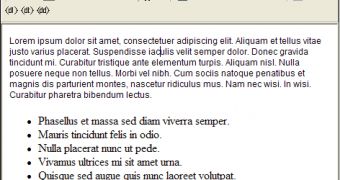The WYSIWYG (What You See Is What You Get) concept is present in almost every content creation or update action performed over the web. The WYSIWYG principle implies that in the final form, the published version, the content will have a similar structure and appearance with the one obtained during the editing process.
Modern web applications and sites have implemented WYSIWYG editors as necessary functionality both for users (in case of comments or feedback forms, forums posts and more) and administrators who update or add content to a website with the help of online visual tools. For example, almost all content management systems provide in administration control panel a WYSIWYG HTML editor or the possibility to add one as plug-in.
WYSYWYG editors allow persons that do not have technical skills to add or edit website content in a visual manner because they automatically generate the necessary HTML code to reflect certain user actions, like changing the text heading, adding or resizing an image, inserting audio or video files in web pages and more. The web based WYSIWYG editors are widely used because they require only a browser to run and allow users to perform website content modification online, without the need to use supplementary FTP programs or to install third party applications.
The most popular WYSIWYG editors are written in JavaScript-DHTML and many of them also use AJAX technology. These editors ensure a maximum degree of compatibility with the majority of web browsers, have a high loading speed (the source code is compressed) and provide easy to understand graphical user interfaces.
Xinha is an easy to configure and implement WYSIWYG HTML editor compatible with browsers based on Gecko engine and Internet Explorer. It can be added to any type of application ranging from a simple one field form editor to complex website updating tools. Another lightweight and fast web based HTML editor is FCKeditor. It outputs XHTML 1.0, automatically detects user language (offers multilanguage support) and can be integrated in any server side application.
TinyMCE allows you to transform any HTML element into a WYSIWYG editable object. There are multiple customization options available for this editor. For example, through Gzip compression method on server side, TinyMCE file sizes are reduced up to 75%. The content update could also be performed by employing AJAX technology (without refreshing the current page) in a few lines of code.
WYMeditor is a WYSIWYM (What You See Is What You Mean) XHTML editor that outputs structured XHTML code in compliance with W3C standards. The user cannot alter the code due to the separation between the layout and content structure. The results are reflected in better information management. WYMeditor performance and usability is close to a WYSIWYG HTML editor.
NicEdit and Damn Small Rich Text Editor are two examples of applications based on AJAX technology that allows you to add online content editing features to your applications. By using WYSIWYG editors of this type, the web page element editing functionality can be added in a global manner and only with a few lines of code. If you have a blog or a content management system, Loki (a semantic WYSIWYG XHTML editor) provides integration possibilities through RSS feeds.
The applications presented in this article should demonstrate the endless integration options and editing capabilities of web based WYSIWYG HTML editors. The selection of an appropriate editor for a certain project will depend on various factors like integration possibilities, editor file size, editor graphical user interface and more.

 14 DAY TRIAL //
14 DAY TRIAL //